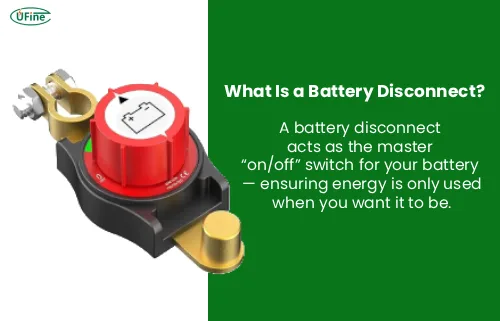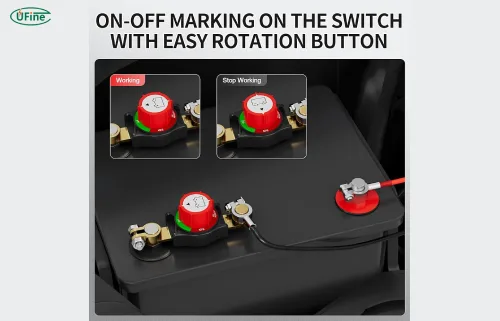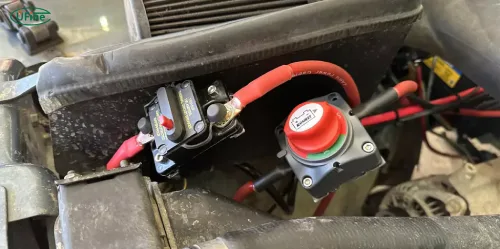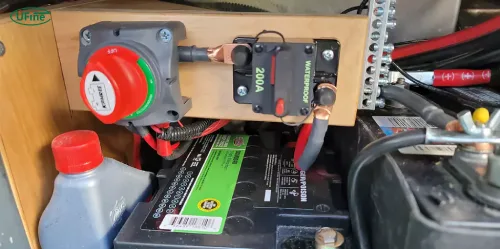
- Part 1. Why would someone need a battery disconnect?
- Part 2. When should you turn a battery disconnect on or off?
- Part 3. What are the common types of battery disconnect switches?
- Part 4. How to choose the right battery disconnect switch
- Part 5. Where and how is a battery disconnect installed?
- Part 6. What are the risks of not using a battery disconnect?
- Part 7. What are the special use cases (RVs, boats, and solar systems)?
- Part 8. How do maintenance and monitoring tie into a battery disconnect?
- Part 9. What are the trending features and future developments?
- Part 10. Conclusion: Is a battery disconnect right for you?
- Part 11. FAQs
Quick Answer: A battery disconnect — also known as a battery disconnect switch or battery cut-off switch — is a simple yet vital electrical component that isolates a battery from the system it powers. By cutting off the electrical flow when needed, it prevents unnecessary power loss, reduces the risk of short circuits, and provides a quick way to shut down a vehicle or power system for safety and maintenance.
In short, a battery disconnect acts as the master “on/off” switch for your battery — ensuring energy is only used when you want it to be.
Part 1. Why would someone need a battery disconnect?
A battery disconnect is not just for convenience; it serves several critical functions.
- Prevents parasitic drain: Many modern vehicles, RVs, and boats draw small amounts of current even when not in use (from onboard computers, clocks, and alarm systems). Over time, these parasitic loads can drain a battery completely.
- Improves safety: It provides a fast way to cut power during an emergency, reducing the risk of electrical fires or damage.
- Extends battery life: Disconnecting the battery during storage reduces chemical degradation caused by partial discharge cycles.
- Theft prevention: When disconnected, the vehicle or system cannot easily be started, adding a layer of security.
- Simplifies maintenance: Technicians can safely service electrical systems without the risk of sparks or accidental shorting.
A well-installed battery disconnect is therefore a small investment that pays off in safety, reliability, and longer battery service life.
Part 2. When should you turn a battery disconnect on or off?
The timing depends on how and where the system is used. The following table summarizes the most common cases:
| Scenario | Disconnect Switch Position | Purpose |
|---|---|---|
| Vehicle in regular use | ON | Normal operation |
| Vehicle in long-term storage | OFF | Prevents parasitic drain |
| RV or camper in winter storage | OFF | Preserves battery charge |
| Boat docked for weeks | OFF | Safety and corrosion prevention |
| During system maintenance | OFF | Protects from electrical shock |
| Emergency situation | OFF | Cuts all electrical power instantly |
In general, the switch should remain ON during normal operation, and OFF during any long-term storage, repairs, or emergency shutdowns.
Part 3. What are the common types of battery disconnect switches?
Battery disconnects come in different forms depending on the application, current load, and environment.
| Type | Operation | Typical Application | Pros | Cons |
|---|---|---|---|---|
| Manual knob or lever | Turn or twist by hand | Cars, small boats | Simple, inexpensive | Requires physical access |
| Keyed switch | Operated by a removable key | Vehicles, anti-theft systems | Adds security | Keys can be lost |
| Remote electric (solenoid) | Controlled by a switch or button | RVs, solar systems | Convenient, allows remote control | Higher cost, more wiring |
| Automatic battery disconnect | Triggered by voltage or timer | Off-grid or fleet vehicles | Smart energy management | Complex, more expensive |
Selecting the right type depends on whether you prioritize convenience, cost, or security.
Part 4. How to choose the right battery disconnect switch
Selecting a proper battery disconnect switch involves more than just size or brand. It requires understanding your system’s electrical characteristics and environment.
Key factors to consider:
- Voltage rating: Ensure the switch matches your battery system — 12 V for automotive, 24 V for marine or industrial, and up to 48 V for solar setups.
- Current rating: The switch must handle both continuous current and surge (starting) current. For most cars, 100–200 A is sufficient; for heavy-duty or RV systems, look for 300 A or more.
- Mounting location: Under-hood, dashboard, or near the battery. Choose corrosion-resistant materials if used in humid or marine environments.
- Accessibility: For emergencies, the switch should be easy to reach or remotely controlled.
- Durability: Look for waterproofing (IP ratings), vibration resistance, and solid-metal contacts.
Quick selection checklist:
| Requirement | Recommendation |
|---|---|
| Vehicle use | Manual or keyed type |
| RV or off-grid system | Remote or automatic type |
| Marine or outdoor use | Sealed, corrosion-proof switch |
| Heavy-duty truck or equipment | High-current rated (300 A+) |
| Anti-theft purpose | Keyed or hidden disconnect |
Part 5. Where and how is a battery disconnect installed?
A battery disconnect is typically installed on the negative cable between the battery and the electrical system. This minimizes the risk of short circuits and makes it easy to isolate the entire system.
1 Basic installation steps:
- Turn off all power and remove the ignition key.
- Disconnect the negative cable from the battery.
- Mount the switch on a stable, accessible surface near the battery.
- Connect the cable from the battery terminal to one side of the switch.
- Attach the load cable (that runs to the vehicle or device) to the other side.
- Tighten all connections and test the switch operation.
2 Safety tips:
- Always disconnect the negative terminal first and reconnect it last.
- Avoid installing the switch in locations exposed to excessive heat or vibration.
- Use insulated tools and protective gloves.
- Label the switch clearly for others who may service the system.
Proper installation ensures both functionality and safety compliance.
Part 6. What are the risks of not using a battery disconnect?
Ignoring the need for a battery disconnect can lead to serious consequences:
- Premature battery failure: Continuous parasitic drain can discharge a battery to unsafe levels, leading to sulfation and capacity loss.
- Fire hazards: Faulty wiring or short circuits can cause overheating if there’s no quick way to isolate the battery.
- Safety risks during maintenance: Accidental contact with live wires can cause sparks, burns, or damage to sensitive electronics.
- Increased downtime: If a battery discharges completely, recharging or replacement can be costly and time-consuming.
- Unauthorized access: Without a disconnect, vehicles and boats are easier to start or tamper with.
A single switch can prevent all these issues, making it a low-cost but high-impact safety upgrade.
Part 7. What are the special use cases (RVs, boats, and solar systems)?
Battery disconnects are used across multiple industries and scenarios.
1 RVs and campers:
- Prevent battery drain during storage.
- Enable easy switching between “storage” and “travel” modes.
- Some RVs integrate a remote disconnect near the entry door for convenience.
2 Boats and marine systems:
- Help protect against electrical corrosion and fire.
- Often required by marine safety regulations.
- Dual-battery systems use switches to control house and engine batteries separately.
3 Solar installations:
- Used between battery banks and inverters for maintenance and emergency isolation.
- Ensure technicians can safely service systems with high DC voltage.
- Smart or automatic disconnects are common in large solar arrays and off-grid homes.
| Application | Key Function | Typical Switch Type |
|---|---|---|
| RV / Camper | Storage mode isolation | Manual or remote |
| Boat / Marine | Safety & corrosion prevention | Waterproof manual |
| Solar / Off-grid | Maintenance and emergency shutoff | High-voltage remote or automatic |
Each use case prioritizes safety, accessibility, and compatibility with the system’s power capacity.
Part 8. How do maintenance and monitoring tie into a battery disconnect?
A battery disconnect simplifies maintenance but also requires basic care to ensure reliable operation.
Routine maintenance tips:
- Periodically turn the switch on and off to prevent internal corrosion or sticking.
- Check all connections for looseness or oxidation.
- Clean terminals with a mixture of baking soda and water if corrosion is visible.
- Inspect cables for fraying, especially near the switch.
Battery monitoring:
When a disconnect is used for long-term storage, check voltage at least once a month. A fully charged 12-volt battery should read about 12.6 – 12.8 V. If voltage drops below 12.2 V, recharge it before further discharge occurs.
Good maintenance habits ensure the disconnect switch and battery system stay reliable for years.
Part 9. What are the trending features and future developments?
Battery disconnect technology is evolving rapidly, driven by the growth of electric vehicles, solar systems, and smart energy management.
Emerging trends include:
- Remote and wireless control: Smart disconnects can now be activated via mobile apps or integrated with Bluetooth systems.
- Integrated sensors: Some models monitor voltage, current, and temperature, automatically disconnecting to protect batteries from deep discharge or overheating.
- Solid-state switching: Instead of mechanical contacts, advanced disconnects use semiconductor devices for faster and safer operation.
- Integration with Battery Management Systems (BMS): High-end lithium-ion systems can automatically isolate faulty cells or modules.
- Eco-friendly design: Manufacturers are using recyclable materials and compact housings to reduce environmental impact.
These innovations are making battery disconnects more intelligent, reliable, and aligned with modern energy systems.
Part 10. Conclusion: Is a battery disconnect right for you?
If you own a vehicle, RV, boat, or solar power system, a battery disconnect is one of the simplest upgrades to improve safety, extend battery life, and reduce maintenance headaches. It provides peace of mind — knowing that with one switch, you can control your entire electrical system.
When choosing a disconnect switch, always match it to your voltage and current needs, consider the environment it operates in, and ensure it’s easily accessible in emergencies.
Whether you’re preventing battery drain during winter storage or protecting a complex off-grid system, the battery disconnect remains a small device with a big impact on performance and safety.
Part 11. FAQs
Can a battery disconnect drain the battery if left connected?
No. When installed correctly, a battery disconnect does not draw power. However, if the switch is faulty or left partially engaged, minor leakage current may occur. Always ensure full contact or complete disconnection.
Does a battery disconnect affect the vehicle’s computer or radio settings?
Yes, disconnecting the battery will reset memory-based systems such as radio presets, clock, and ECU adaptations. Some modern vehicles use memory savers to retain these settings during battery isolation.
Can I install multiple battery disconnect switches in one system?
Yes, large systems often use multiple disconnects to isolate different circuits — for example, separating the starter battery from the auxiliary or solar battery bank. Each switch should be properly rated and labeled to avoid confusion.
Is it safe to use a battery disconnect switch while the engine is running?
No. Disconnecting the battery during operation can cause voltage spikes that may damage the alternator, ECU, or other sensitive electronics. Always shut off the engine before using the disconnect.
How long can a battery stay disconnected without damage?
Lead-acid batteries can typically remain disconnected for 3–6 months if stored in a cool, dry place and fully charged beforehand. Lithium batteries may last even longer. Regular voltage checks are recommended during long storage periods.
Related Tags:
More Articles

100AH Golf Cart Battery Life: How Long Can It Last?
Wondering about your 100AH golf cart battery's lifespan? Find out what affects its longevity and how to keep it running longer. Read now!
Do Car Battery Testers Really Work Accurately?
Discover how car battery testers work, their accuracy levels, and which type gives the most reliable results for your vehicle.
Why Do Batteries Get Sulfated and How Can You Prevent It?
Learn what causes sulfated car batteries, how to fix them with desulfation charging, and expert tips to prevent future battery damage and failure.
How Long Does a 22NF Battery Last and What Does It Mean?
Learn what 22NF means, its size, specs, types, and lifespan. Find the best 22NF battery for your vehicle or equipment with expert guidance.
The Complete Guide to 4D Batteries: Size, Specs, Price & Lifespan
Learn what a 4D battery is, how it works, specs, size, and price. Compare AGM vs lithium 4D batteries and find where to buy them safely.






